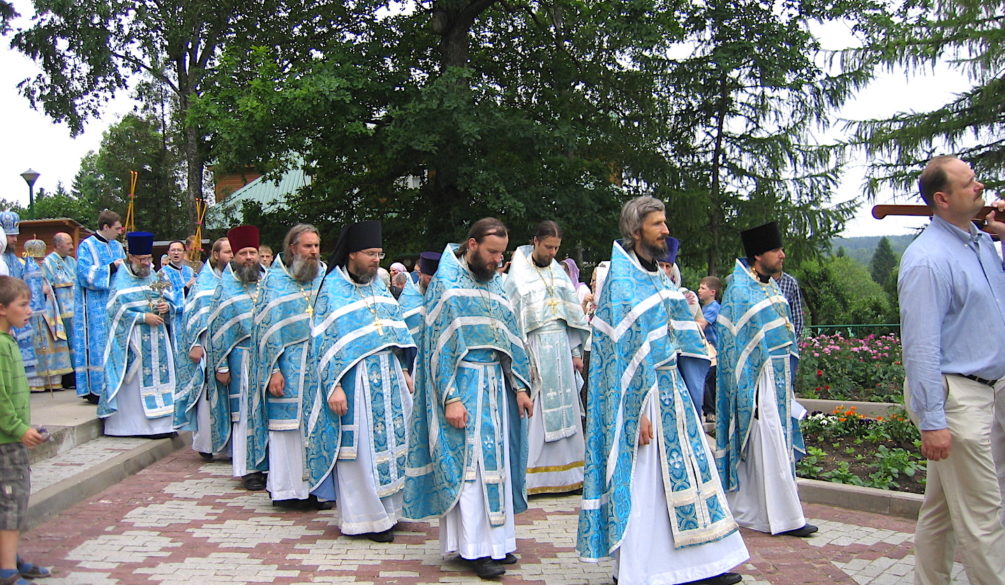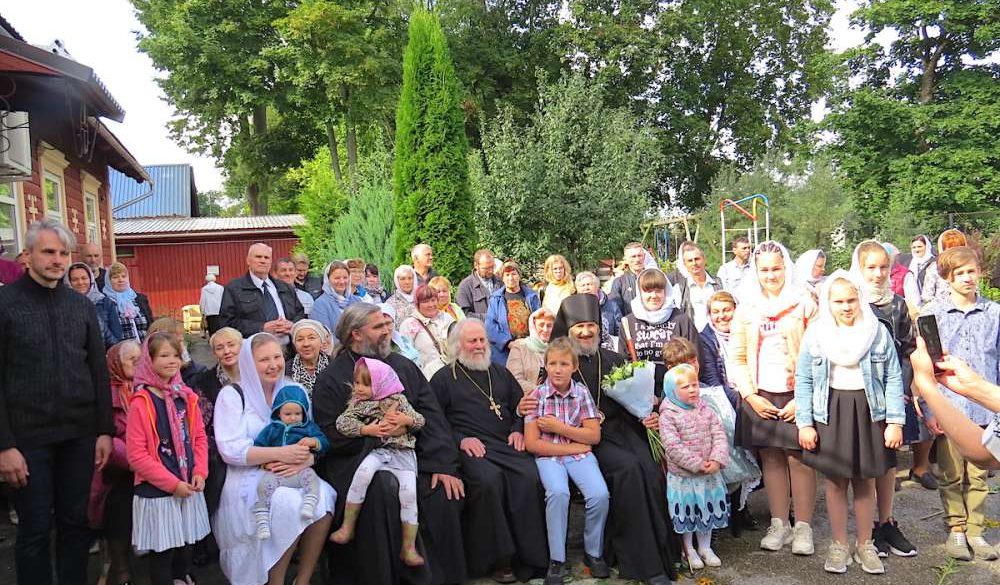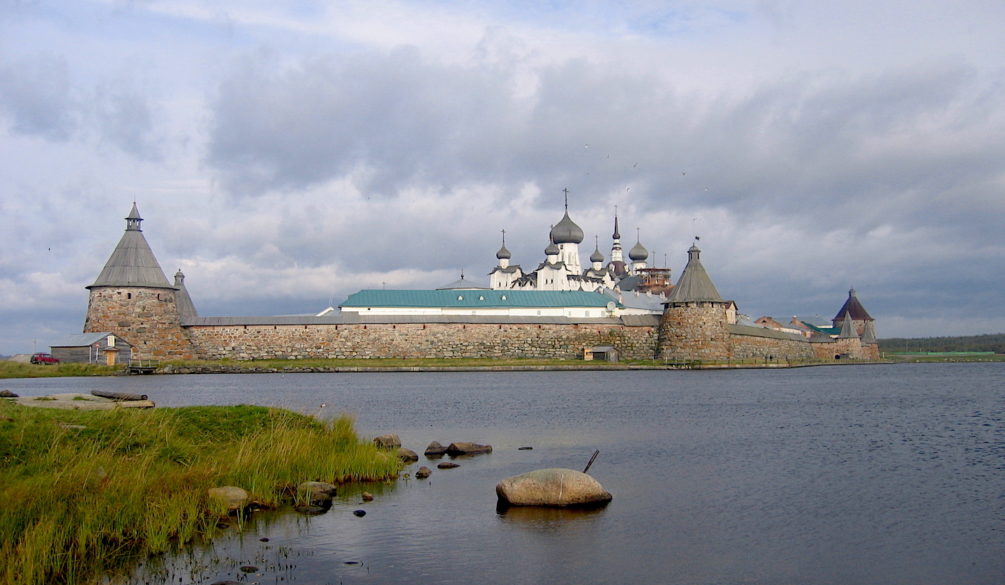2021
July 1, 2011 Pyukhtitsky Holy Dormition Monastery
Pühtitsa (Est. – Sacred place) is a village in Vesenberg county, Estland province, on the border of Pskov and S.-Petersburg provinces. Petersburg guberniya, 16 versts to the northwest from Lake Peipsi; part of the village is inhabited by Russian peasants, part of the so-called “Poluvertsy” i.e., Oluteran Russians, who migrated here from across the Lake Peipsi for fishing in the 15th century. There is a church and a nunnery near Pyukhtitsa, on the Bogoroditskaya Mountain, founded in 1892. The latter has a health center, an asylum (30 girls), a school and workshops for icon painters, gold embroiderers, and swordsmen. F.A.Brockhaus and I.A.Efron Encyclopaedic Dictionary, S.-Petersburg, 1890-1907.
The mountain of Bogoroditsky, on the top of which the Pyukhtitsa Holy Dormition Monastery is located, has had the name of Kuremäe (Crane Mountain) from ancient times. Back in XII-XIII centuries a trade route ran through these places, connecting Novgorod and Pskov lands with ancient Estonian cities Yuriev (Tartu) and Kolyvan (Tallinn). In those distant times the first Russian settlements appeared in the area. Since XIII century with the expansion of Crusaders Catholicization of the region began. Still, a part of the population remained faithful to Orthodoxy and sought support in it. When Lutheranism was introduced in Estonia (in the first half of the 16th century), it brought hard times for non-Christians. Orthodox churches and chapels were destroyed. Worship services were held in German, not understandable to the Estonians. In the 15th century, there were martyrs for the Orthodox faith. In ancient Yur’ev in 1472 Presbyter Isidor of St. Nicholas Church and 72 parishioners were seized on the river Omovzha during the Epiphany water blessing, imprisoned and two days later thrown under the ice in the same Jordan, where they went out to celebrate the Epiphany. And so, in this place, as a consolation to the people of Estonia, exhausted in their impossible struggle against the Teutonic Knights, the Mother of God appeared.
According to the sixteenth-century Sirenets Chronicle, there was a sign in Kuremäe more than four centuries ago. Early on a summer morning, shepherds saw the Blessed Virgin Mary in a marvelous azure robe on the mountain. They rushed up the mountain – the vision disappeared. As they moved away, she reappeared in front of them. When the shepherds returned home, they told the people of their village. The next day, at dawn, the villagers went to the mountain, and they too saw the Blessed Virgin Mary, standing in the glow of wondrous light… On the third day, the peasants from all the surrounding villages gathered around the mountain. And again the Blessed Virgin honored them with her apparition. She stood at the foot of the mountain, where there was a spring of spring water. Then the Blessed Virgin began to ascend higher and higher, and stopped at a majestic oak tree and disappeared from their sight. At the place where the Blessed Virgin Mary stood, the villagers found an icon of the Dormition of the Mother of God in a crevice of the oak. The Estonian peasants, being Lutherans, handed the icon over to the Orthodox, who built a chapel dedicated to the Dormition of the Mother of God at the site of the apparition at the ancient oak tree and placed the icon there. Since then, the Crane Mountain began to be called Pyukhtitsa, i.e. the Holy Mountain.
Nowadays the icon, covered in a silver gilded riza decorated with precious stones, stands at the right pylon of the central aisle of the Assumption cathedral. The source, from the shore of which the shepherd watched the sign, is considered holy. It does not freeze up in cold winters. Bathing in it has helped many to get rid of severe ailments. The old oak tree under which the image of the Dormition of the Mother of God was found is still preserved. Scientists believe that it is at least 1000 years old. Its height is 26.5 meters, the girth of the trunk is over 4 meters. It is also revered as a holy, and everyone who came here tried to chip off at least a piece of its bark. Today, a fence was built around the ancient giant. And next to it there is a reconstructed chapel of the 16th century, inside which there is an old chapel.
2021
Estonia September 6, 2020 Valga Church of the Vladimir Icon of the Mother of God
Estonia September 6, 2020 Valga Church of the Vladimir Icon of the Mother of God
2019
Russia Spaso-Preobrazhensky Solovetsky Monastery September 2009
Monasteries, according to St. Philaret (Drozdov), were the “spiritual stronghold” of Orthodoxy. Pilgrims went to the holy monasteries not only to worship the shrines,
but also to experience the correct Christian life. The believers were guided by the words of John of the Ladder: “The light of the monks is the Angels, the monks are the light for
all men.”
In ordinary life, in the hustle and bustle of everyday worries, the intensity of spiritual life weakened. Coming to the monasteries, the pilgrims observed a strict monastic life
– for them, it was a true Christian life – and then they tried to imitate it in the world. In the monasteries, the usual prayers and chants sounded in a special way. Each of
them had its own saints. The monastery was a living illustration of the lives familiar to many from childhood. The moral feat of the saints inspired a righteous
life. The life according to the commandments of Christ was also promoted by the advice of experienced elders. People from all walks of Russian society sought them for spiritual conversation in the monastery
. Visiting the monasteries morally cleansed, strengthened in faith and piety.
Sometimes, after returning from a pilgrimage, people changed their entire lives. The religious philosopher and historian Prince Sergei Trubetskoy considered monasteries “a place of spiritual
and moral education of the people”. Having received a charge of faith here, the pilgrims then carried it to the world.
Solovki has always attracted pilgrims seeking the shrine. But many participants of scientific expeditions, foreign
travelers, writers, and industrialists also came to the islands. They found their interest here – business, scientific, educational. Everyone perceived Solovki in their own way, but
all visitors noted that there is a special world here, different from their ordinary worldly life. People sometimes began to think for the first time that
there is another life — high and spiritual. And today Solovki is visited not only by Orthodox pilgrims. The islands are
still open to everyone. Here everyone finds something that is interesting to the mind and dear to the heart. A visit to the Solovetsky Islands always enriches you with new knowledge,
impressions, and joyful experiences. Let it at the same time open the door to the world of the Orthodox monastery for some, and make this world more open for others.
close and understandable, and someone may want to come back here again. Let everyone here feel the joy of coming into contact with the shrine and
keep the bright feelings experienced in their soul as long as possible. Spaso-Preobrazhensky Solovetsky Stavropol monastery.
Viceroy Archimandrite Porfiry









